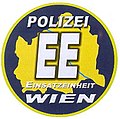Mission unit (Austria)
In Austria, special police units are called operational units (EE) , which primarily perform the tasks of the Great Security and Order Service (GSOD). These primarily include regulatory police operations such as securing demonstrations , football matches and state visits. All members of the operational units volunteer there. This results in a high level of commitment and motivation among the troops. These units are comparable to the German riot police .
Training and recruiting
Every civil servant who would like to serve at EE must pass a performance test, which is checked every two years. Likewise, each applicant must explain to an officer and an officer in charge of the EE his motivation for applying to the EE. As with the respective operations, the EE members are also drawn together for exercises. Tactical formation as well as operational techniques and handling of the available operational resources and weapons are trained.
equipment
All officers of the operational unit have the following equipment:
- Glock 17
- helmet
- Body armor
- Plexiglass sign
- Irritant sprayer RSG8
- Baton
Specially trained officers can also be assigned the HK69 multi-purpose pistol for firing tear gas and an IFEX device.
Areas of application
In the case of large-scale police situations such as state visits, demonstrations, the use against hooligans but also search measures (especially in rural areas), the specially trained officers of the operational unit are requested. In normal cases, the officers are drawn together in the run-up to GSOD situations where violent clashes cannot be ruled out. At most of the rallies registered in accordance with the Assembly Act in Austria, officials from the Federal Police are on site as standard, as are most of the games in the Austrian Bundesliga . Only in those cases in which a violent potential is recognized by the assembly authority, officers of the emergency unit are called in (for example at high-risk football games).
organization
The operational units are subordinate to the individual state police departments and have their organizational headquarters there. They are composed of officials who do their normal duty in different police stations . If necessary, the officers from the police inspections are brought together centrally and equipped with special equipment, e.g. B. with protective shields . The EE officers are personally assigned the appropriate equipment ( batons , helmets , body protection, protective gloves).
All nine federal states have their own sleeve badge, a nickname and some units have their own motto. For example, the motto of EE Wien with the nickname “ULAN” is Viribus Unitis (meaning: “with united forces”). The officers of the operational units can be recognized by their black berets .
The deployment unit is divided into so-called deployment trains. An emergency train usually consists of 5 groups, with 6 to 8 officers in each group. Each state police headquarters and thus also each federal state are usually subordinate to several trains, which can also be used in other federal states if necessary (often the case at football matches in the Austrian Bundesliga). The organizational and operational departments of the state police headquarters are responsible for providing the operational units. In Vienna , the standby unit can also be called in for low- and medium-threshold occasions (where a quick pulling together of forces is required) as well as the WEGA for major security situations.
Tactical distinction
To tactically differentiate the officers from one another, they use so-called "tactical distinctive signs" that are attached to the operational overalls on the back and on the helmet at the back. In this way, on the one hand, the functions of the officials concerned within their unit and, on the other hand, their membership in a unit can easily be recognized.
| state | Nickname | Abbreviation |
|---|---|---|
| Burgenland | WULKA | B. |
| Carinthia | LYNX | K |
| Lower Austria | SCHNEEBERG | N |
| Upper Austria | LENTOS | O |
| Salzburg | TAURUS | S. |
| Styria | DACHSTEIN | ST |
| Tyrol | HAWK | T |
| Vorarlberg | PLEDGE | V |
| Vienna | ULAN | U |
| Vienna (ODE) 1 | DOLPHIN | D. |
| Vienna (BE) 2 | TOSCA | BE |
1 The security service unit in Vienna (see next paragraph) is not an operational unit in the strict sense, but still uses its own nickname and its own identifier.
2 Although the standby unit in Vienna (see next paragraph) is also not an operational unit in the actual sense, it is called in in the event of unforeseeable major events in which a rapid contraction of forces is required.
Security service unit - standby unit
In addition to the EE that can, if necessary, standby unit (especially when unforeseen major events) and the so-called security service units (in Vienna earlier ODE Reserverkompanien called) are drawn together. The security units are also composed of officers on duty at the police stations. Each police officer is assigned to an ODE, in contrast to voluntary membership in the EE. That is why the majority of the forces deployed at major events are those of the security units. In contrast to the EE or WEGA, the officers of the stewardship units do not receive any special training and the equipment is not assigned to them personally, except for the protective helmet.
literature
- Siegbert Lattacher: Units for security service (PDF; 76 kB). In: Public Safety . Special edition 12a, 2005, p. 55.
- Wolfdieter Hufnagl: Special units of the Austrian police and gendarmerie. Motorbuch-Verlag, Stuttgart 1999, ISBN 3-613-01941-8 .
Individual evidence
- ↑ Distinguishing signs of the Austrian units at the Euro 08 (PDF; 183 kB)
- ↑ From B as in standby unit to W as in WEGA . Published on Papiertiger's blog , accessed April 7, 2014.







